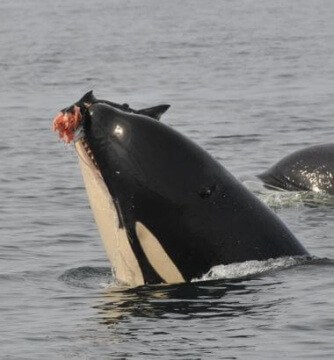June finished in fantastic fashion with orca whale watching sightings in the San Juan Islands on almost every day of the month. Our San Juan Islands kayaking tours encountered killer whales on nearly all of the camping trips! All of our 5-day San Juan kayak expeditions saw both orca whales and porpoises. All of the 3-day San Juan kayaking trips found killer whales, too. Our 2-day San Juan kayak tours scored a 60% success rate for orca whale watching in June, but managed to see at least one species of cetacean on all the tours. And finally, the 1-day San Juan kayaking trips succeeded in finding cetaceans on 94% of the trips in June, with killer whales seen on 74% of the trips. On the few trips that we missed them, it was often by mere minutes!
The summer diet of Washington’s killer whales consists mainly of an endangered species of salmon that spawns in a nearby river in Canada. Orca whales in the San Juan Islands prey heavily on chinook salmon from British Columbia’s Fraser River, underscoring the connected nature of the Salish Sea’s threatened ecosystem. The chinook is the largest of all salmon species and is the killer whales’ favorite as they provide the largest meal for the effort expended.
From 2004-08, scientists in the San Juan Islands tracked the J, K and L pods of orcas (the families that make up the “Southern Resident Community” of killer whales) to learn what they were eating and where their food came from. The work involved following the orcas in small boats and gathering killer whale excrement, regurgitations, fish scales and other tissue with a fine mesh net. The scientists were often alerted by a dog specially trained to smell orca poop!
Examination, including DNA testing, revealed that orcas select chinook salmon almost exclusively, despite far more abundant numbers of sockeye and humpback salmon in the area. DNA indicated that 80-90% of the chinook salmon fish came from British Columbia’s Fraser River, and only 6-14% from Puget Sound rivers.

This is not a surprise as the rivers in Puget Sound have been much more severely damaged by careless human activities and produce far fewer salmon than the rivers of Canada. The strongest run of Puget Sound chinook remaining is from the Skagit River where 25,000 chinook spawn. The Fraser River of Canada has runs at least four times larger, plus millions more of sockeye and other salmon species.
The San Juan Islands are perfectly situated so that runs of chinook must migrate along its shores en route to both of these productive rivers. This makes the San Juan Islands the ideal location for the orca whales to intercept salmon finding their way home to rivers in British Columbia and Washington. And that in turn makes the San Juan Island’s west side the best place to kayak with killer whales in the entire United States.
Join a Kayak Quest for Whales in the San Juan Islands of Washington
Photo credit to Astrid Van Ginnekin from the Center for Whale Research.
